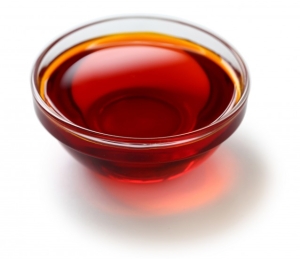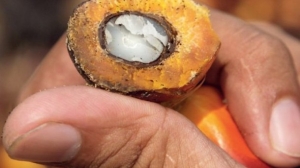PALM FRUIT and its OIL is a Wonderful Gift of Nature to us.
It is the only fruit known to mankind which offers two Entirely different type of oils in properties and characteristics and can be used commercially.
Two kinds of oil are obtained from the fruit, ‘palm oil’ and ‘palm kernel oil’.
Palm oil and derivates
 Palm oil is extracted from the fleshy, fibrous mesocarp (outer layer or pulp) of the fruit which contains 45-55% oil. Palm oil and derivates are solid at ambient temperature in the tropics, melting at 25°-50°C and ranging in consistency from that of soft butter to a hard, tallow-like substance, depending on the methods of extraction and processing.
Palm oil is extracted from the fleshy, fibrous mesocarp (outer layer or pulp) of the fruit which contains 45-55% oil. Palm oil and derivates are solid at ambient temperature in the tropics, melting at 25°-50°C and ranging in consistency from that of soft butter to a hard, tallow-like substance, depending on the methods of extraction and processing.
Red Palm oil is a good source of energy and rich in carotenes, from which it derives its pale yellow to deep orange colour. It is a rich source of vitamin E and vitamin A and acts as a carrier of these in the human body. The main fatty acids present in the palm oil are palmitic acid (saturated), and oleic acid (unsaturated).
The fatty acid composition of the palm oil is 40-52% oleic acid, 35-45% palmitic acid, 5-10% lineoleic acid, 3-8% stearic acid and 2-5% myristic acid, giving it a higher unsaturated acid content than palm kernel oil and coconut oil. Palm oil has a mean slip melting point of 34.2°C (range 31-38°C), titre at about 45°C (range 42-46°C) and has an iodine value of 52.9 (range 51-55).
A recent Malaysian development has led to the production of palm oil using milder processing conditions so that important phytochemicals originally present in crude palm oil (CPO) are retained in the refined palm oil. The processing has two stages – pretreatment of CPO followed by deodorization and deacidification by molecular distillation. The milder conditions in the second stage allow most of the carotenes to be retained. This palm oil has a mean slip melting point of 21.6°C (range 19-24°C) and has an iodine value of 58 (range 56-61).
Palm stearin is the more solid fraction obtained by fractionation of palm oil after crystallization at a controlled temperature. The physical characteristics of stearin differ significantly from those of palm oil and it is available in a wider range of fatty acid and triglyceride compositions. It is a source of fully natural hard fat components and has a mean slip melting point range of 44-56°C.
Composition of palm kernel oil
Palm kernel oil is extracted from the kernels which contain about 50% oil. It is a hard oil, similar to coconut oil, with which it is readily interchangeable. The major fatty acids in palm kernel oil are about 48% lauric acid, 16% myristic acid and 15% oleic acid, no other fatty acid is present at more than 10%. Palm kernel oil is about 82% saturated, which is much more than the major liquid oils, such as soybean which is only 16% saturated or sunflower oil which is 12% saturated. Because of the predominance of lauric acid the oil is solid at ambient temperatures in temperate areas combined with a low melting point (about 34-36°C). It leaves a clean, cool, non-greasy sensation on the palate, impossible to match by any of the common non-lauric oils. Cacao /coco butter has the same properties but is much more expensive. Kernel oil is nearly colourless, varying from white to slightly yellow with iodine values in the range of 14-22.
Multiple uses:
The oil palm has a multiple uses and every part of the palm can be utilized.
Palm oil is used for edible purposes, including the manufacture of margarine and compound cooking fats. Industrially it is used principally in the manufacture of soap, lubricating oils and candles. Palm oil is used extensively in the tin plate industry, protecting cleaned iron surfaces before the tin is applied. It is also used as lubricant in textile and rubber industries. A recent innovation is the use of palm oil as an environment-friendly carrier in pesticide formulations.
 Red palm oil can be used as cooking oil for spicy food, such as curry, sauce, or other dishes which it gives a reddish colour. It can also be used as a portion in margarine blend to provide a natural source of colouring and a desired level of vitamin A, and as a nutritional ingredient for instant noodles, salad dressing and peanut butter. It is ideal for stir-fried dishes but is not recommended for repeated use, since the carotenes will be degraded.
Red palm oil can be used as cooking oil for spicy food, such as curry, sauce, or other dishes which it gives a reddish colour. It can also be used as a portion in margarine blend to provide a natural source of colouring and a desired level of vitamin A, and as a nutritional ingredient for instant noodles, salad dressing and peanut butter. It is ideal for stir-fried dishes but is not recommended for repeated use, since the carotenes will be degraded.
Palm stearin is used for products such as shortenings (substitute for lard), pastry margarines, vanaspeti (vegetable ghee, substitute for butter fat), etc.
Kernel oil can be used as cooking oil or edible fat, in making ice cream and mayonnaise, in the confectionery and bakery trade, as a substitute for cacao butter and also in the manufacture of toilet soaps, soap powders and detergents. In West Africa it is used as hair oil and skin lotion, and is often mixed with imported scents. Mixed with kerosene, it is used as a furniture polish. It is sometimes used in traditional medicine.
In the oleochemical industry kernel oil is now used for the manufacture of short chain fatty acids, fatty alcohols, methyl esters, fatty amines, amides, etc, for use in detergents, cosmetics and many other products.
Palm wine can be consumed in a variety of flavours varying from sweet unfermented to sour fermented and vinegary alcoholic drinks. The fresh sap is sweet, (as it contains about 4.3-4.5 g/100 mlsucrose and 3.4-3.5 g/100 ml glucose), nutritious, clear, and colourless and with a neutral reaction. It ferments quickly to produce a more piquant drink. The drink has a milky flocculent appearance, caused mainly by suspended yeast cells, and a slightly sulphurous odour. It is an important source of vitamin B. The production of palm wine excludes the production of palm oil. However, the mean annual yield per hectare of 150 palms is 4000 litres, which, in some areas, has double the value of the palm oil and palm kernel oil that could have been produced by the same number of palms.
Palm cabbage the sweet, delicate central stem and bud (heart-of-palm) cut from the young palm, is, like the cabbage from other palms, eaten as a salad vegetable. The heart-of-palm is composed of the tender undeveloped leaves immediately above the apical meristem, each younger leaf wrapped within the petiole-sheath of the next older leaf. Immediately below the apical meristem there is a variable sized (5-20 cm long) portion of differentiating stem, which is tender enough to be eaten fresh. This by-product has the same flavour as the heart-of-palm, but a different appearance and texture.
For cabbage production the stem should be cut as soon as it attains the optimum size for the target market. Harvest destroys the palm. Export quality heart-of-palm is determined by the tenderness of the petiole-sheath; if it is too fibrous to be cut easily with a sharp knife it is too fibrous for export.
Its nutritional qualities makes it a product which perfectly matches modern demands for low calorie, healthy eating.
Leaves can be used for thatching and shade; petioles and rachises for fencing and for burglary protection on the tops of walls in the same way as broken glass or barked wire are used.
Leaves and empty fruit bunches have a high content of cellulose and can be processed into pulp. The pulp can blended with other types of pulp to be used for the production of paper. Several types of papers such as kraft, printing, industrial and newsprint papers can be produced. The cellulose fibre that is similar to coconut coir can also be used for mattresses, fibre boards, and agricultural mats and in the automotive industry.
By products
 It can be expected that 10 tonnes of fresh fruit bunch processed will yield 1.4-2.4 tonnes of crude palm oil and 300-450 kg of palm kernels. Thus between 72 to 83% of the fruit bunch are left as a side product.
It can be expected that 10 tonnes of fresh fruit bunch processed will yield 1.4-2.4 tonnes of crude palm oil and 300-450 kg of palm kernels. Thus between 72 to 83% of the fruit bunch are left as a side product.
Solid by products from the milling operations include: empty fruit bunches, palm press fibre, kernel shells and palm kernel press cake for animal feed
Empty fruit bunches should be returned to the planting as mulch to enhance moisture retention, soil nutrient content and soil organic matter. The material can also be turned into a rich compost. If this is not possible then they can be sun dried and used as fuel. Using the side products from the fruit bunch processing as fuel, mulch and fertilizer will save costs of wood fuel, irrigation and chemical fertilizers.
Palm press fibre is acceptable to ruminants at a low level of inclusion in the diet. Crude protein and crude fibre digestibility decreases when the level of inclusion exceeds 25-30%. The fibre can be dried and pelleted to overcome the problems of poor keeping quality and bulkiness.
Kernel shells can be used as a source of fuel. Unfortunately the shells contain silicates that form a scale in the boilers if too much shell is fed to the furnace, thus only limited amounts of shells should be used. In some areas shells are sold as fuel material for blacksmiths or for the preparation of ‘pozzolana’, a cement substitute. The shells can also be used as mulch in nursery bags, ‘gravel’ for nursery paths, planting and farm roads or as landfill.
Kernel press cake can, after extraction of oil from the kernels, be used as livestock feed. It is rich in carbohydrate (48%), protein (19%) and oil (5-8%). Despite the high oil content, the kernel press cake is dry and gritty and is not readily accepted by all types of stock. As an ingredient in mixed feeds, its unpalatability is of less importance.
It is largely used for feeding cattle. It tends to produce a firm butter when fed to dairy cattle. A ration of 2-5 kg per day has been found satisfactory for adult cattle. Good results have been obtained from pig rations consisting of 20-30% palm kernel meal. Higher proportions usually cause scouring. It has been claimed, however, that a final pig fattening ration of 62.4% palm kernel meal, 35.1%maize and 2.5% blood meal gives average weekly increases of 4.5 kg. Young pigs do not always like it, and in pig feeding it must always be introduced very gradually. Palm kernel cake or meal tends to produce firm pork of good quality. Palm kernel cake, though seldom used in poultry rations, seems to be palatable to poultry and can replace wheat middlings in the poultry diet. Up to 20% has been included in the diet with good results.
Boiler ash can be recycled as fertilizer and used for factory floor cleaning. The potash in the ashes reacts with the oil to form a weak potash soap that is washed away with water.
Liquid by products
The waste from palm oil purification has been used to feed cattle and pigs on estates where it is produced. Cattle seem to accept up to 40% palm oil sludge in their rations without adverse effects.Palm oil sludge and press fibre combined in equal proportions can constitute up to 50% of the ruminant ration. However, this blend can be stored for no more than a day and a half before it becomes unpalatable. Raw or concentrated palm oil sludge can be absorbed on cassava meal or palm kernel cake and dried into feed cakes.
Solvent-extracted meal is particularly unpalatable and must therefore be mixed with well-liked feeds, such as molasses, and fed in gradually increasing proportions. It is, however, a safe and wholesome material, and if reasonable care is taken in the arrangement of the feeding, it is readily eaten.
Liquid can also be deposited in dug ponds and fermented under both anaerobic and aerobic conditions. When the process is over the sludge accumulated in the bottom of the fermentation ponds can be used as fertilizer and the water can be used for irrigation.
Source MPOB.
 Palm oil is extracted from the fleshy, fibrous mesocarp (outer layer or pulp) of the fruit which contains 45-55% oil. Palm oil and derivates are solid at ambient temperature in the tropics, melting at 25°-50°C and ranging in consistency from that of soft butter to a hard, tallow-like substance, depending on the methods of extraction and processing.
Palm oil is extracted from the fleshy, fibrous mesocarp (outer layer or pulp) of the fruit which contains 45-55% oil. Palm oil and derivates are solid at ambient temperature in the tropics, melting at 25°-50°C and ranging in consistency from that of soft butter to a hard, tallow-like substance, depending on the methods of extraction and processing. Red palm oil can be used as cooking oil for spicy food, such as curry, sauce, or other dishes which it gives a reddish colour. It can also be used as a portion in margarine blend to provide a natural source of colouring and a desired level of vitamin A, and as a nutritional ingredient for instant noodles, salad dressing and peanut butter. It is ideal for stir-fried dishes but is not recommended for repeated use, since the carotenes will be degraded.
Red palm oil can be used as cooking oil for spicy food, such as curry, sauce, or other dishes which it gives a reddish colour. It can also be used as a portion in margarine blend to provide a natural source of colouring and a desired level of vitamin A, and as a nutritional ingredient for instant noodles, salad dressing and peanut butter. It is ideal for stir-fried dishes but is not recommended for repeated use, since the carotenes will be degraded. It can be expected that 10 tonnes of fresh fruit bunch processed will yield 1.4-2.4 tonnes of crude palm oil and 300-450 kg of palm kernels. Thus between 72 to 83% of the fruit bunch are left as a side product.
It can be expected that 10 tonnes of fresh fruit bunch processed will yield 1.4-2.4 tonnes of crude palm oil and 300-450 kg of palm kernels. Thus between 72 to 83% of the fruit bunch are left as a side product.